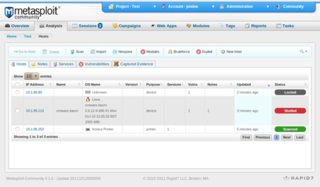SourceForge is a web service that offers software consumers a centralized online location to control and manage open-source software projects and research business software. It provides source code repository hosting, bug tracking, mirroring of downloads for load balancing, a wiki for documentation, developer and user mailing lists, user-support forums, user-written reviews and ratings, a news bulletin, micro-blog for publishing project updates, and other features.
A vulnerability scanner is a computer program designed to assess computers, networks or applications for known weaknesses. These scanners are used to discover the weaknesses of a given system. They are used in the identification and detection of vulnerabilities arising from mis-configurations or flawed programming within a network-based asset such as a firewall, router, web server, application server, etc. Modern vulnerability scanners allow for both authenticated and unauthenticated scans. Modern scanners are typically available as SaaS ; provided over the internet and delivered as a web application. The modern vulnerability scanner often has the ability to customize vulnerability reports as well as the installed software, open ports, certificates and other host information that can be queried as part of its workflow.

Nmap is a network scanner created by Gordon Lyon. Nmap is used to discover hosts and services on a computer network by sending packets and analyzing the responses.
Nessus is a proprietary vulnerability scanner developed by Tenable, Inc.

GnuTLS is a free software implementation of the TLS, SSL and DTLS protocols. It offers an application programming interface (API) for applications to enable secure communication over the network transport layer, as well as interfaces to access X.509, PKCS #12, OpenPGP and other structures.
A source-code-hosting facility is a file archive and web hosting facility for source code of software, documentation, web pages, and other works, accessible either publicly or privately. They are often used by open-source software projects and other multi-developer projects to maintain revision and version history, or version control. Many repositories provide a bug tracking system, and offer release management, mailing lists, and wiki-based project documentation. Software authors generally retain their copyright when software is posted to a code hosting facilities.
Security Administrator Tool for Analyzing Networks (SATAN) was a free software vulnerability scanner for analyzing networked computers. SATAN captured the attention of a broad technical audience, appearing in PC Magazine and drawing threats from the United States Department of Justice. It featured a web interface, complete with forms to enter targets, tables to display results, and context-sensitive tutorials that appeared when a vulnerability had been found.

The Metasploit Project is a computer security project that provides information about security vulnerabilities and aids in penetration testing and IDS signature development. It is owned by Boston, Massachusetts-based security company, Rapid7.
Zeek is a free and open-source software network analysis framework. Vern Paxson began development work on Zeek in 1995 at Lawrence Berkeley National Lab. Zeek is a network security monitor (NSM) but can also be used as a network intrusion detection system (NIDS). The Zeek project releases the software under the BSD license.
On computer networks, a service scan identifies the available network services by attempting to initiate many sessions to different applications with each device in a target group of devices. This is done by sending session initiation packets for many different applications to open ports on all of the devices specified in the target group of devices. This scan is done across a wide range of TCP, UDP. A service scanner will identify each device it finds along with the services that it finds on the ports that it scans.
SAINT is computer software used for scanning computer networks for security vulnerabilities, and exploiting found vulnerabilities.
Lynis is an extensible security audit tool for computer systems running Linux, FreeBSD, macOS, OpenBSD, Solaris, and other Unix derivatives. It assists system administrators and security professionals with scanning a system and its security defenses, with the final goal being system hardening.
Network enumeration is a computing activity in which usernames and info on groups, shares, and services of networked computers are retrieved. It should not be confused with network mapping, which only retrieves information about which servers are connected to a specific network and what operating system runs on them. Network enumeration is the discovery of hosts or devices on a network. Network enumeration tends to use overt discovery protocols such as ICMP and SNMP to gather information. It may also scan various ports on remote hosts for looking for well known services in an attempt to further identify the function of a remote host. The next stage of enumeration is to fingerprint the operating system of the remote host.
The GNOME Core Applications are a software suite of software applications that are packaged as part of the standard free and open-source GNOME desktop environment. GNOME Core Applications have a consistant look and feel to the GNOME desktop, and utilize the Adwaita design language. GNOME Core Applications are developed and maintained through GNOME's official GitLab instance.

Heartbleed is a security bug in some outdated versions of the OpenSSL cryptography library, which is a widely used implementation of the Transport Layer Security (TLS) protocol. It was introduced into the software in 2012 and publicly disclosed in April 2014. Heartbleed could be exploited regardless of whether the vulnerable OpenSSL instance is running as a TLS server or client. It resulted from improper input validation in the implementation of the TLS heartbeat extension. Thus, the bug's name derived from heartbeat. The vulnerability was classified as a buffer over-read, a situation where more data can be read than should be allowed.

ZAP is a dynamic application security testing tool published under the Apache License. When used as a proxy server it allows the user to manipulate all of the traffic that passes through it, including HTTPS encrypted traffic. It can also run in a daemon mode which is then controlled via a REST-based API.
The Nessus Attack Scripting Language, usually referred to as NASL, is a scripting language that is used by vulnerability scanners like Nessus and OpenVAS. With NASL specific attacks can be automated, based on known vulnerabilities.
ZMap is a free and open-source security scanner that was developed as a faster alternative to Nmap. ZMap was designed for information security research and can be used for both white hat and black hat purposes. The tool is able to discover vulnerabilities and their impact, and detect affected IoT devices.
This is a list of cybersecurity information technology. Cybersecurity is security as it is applied to information technology. This includes all technology that stores, manipulates, or moves data, such as computers, data networks, and all devices connected to or included in networks, such as routers and switches. All information technology devices and facilities need to be secured against intrusion, unauthorized use, and vandalism. Additionally, the users of information technology should be protected from theft of assets, extortion, identity theft, loss of privacy and confidentiality of personal information, malicious mischief, damage to equipment, business process compromise, and the general activity of cybercriminals. The public should be protected against acts of cyberterrorism, such as the compromise or loss of the electric power grid.
Tenable, Inc. is a cybersecurity company based in Columbia, Maryland. Its vulnerability scanner software Nessus, developed in 1998, is one of the most widely deployed vulnerability assessment solutions in the cybersecurity industry. As of December 31, 2023, the company had approximately 44,000 customers, including 65% of the Fortune 500.





